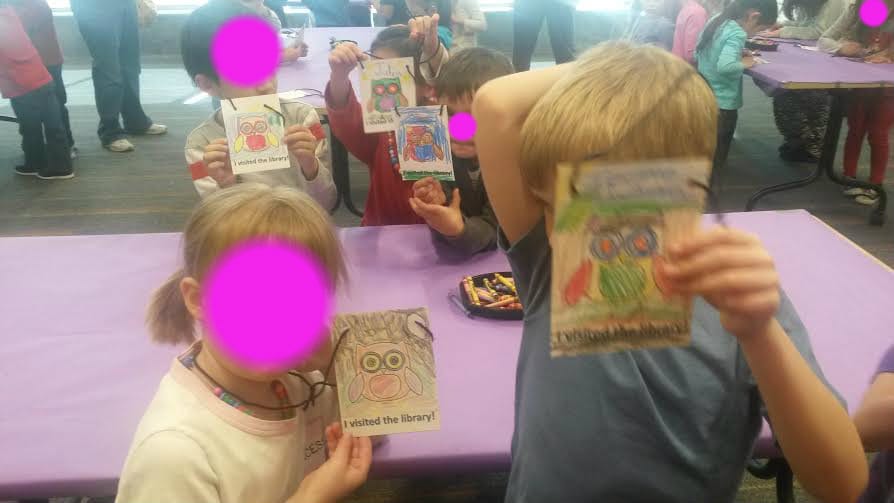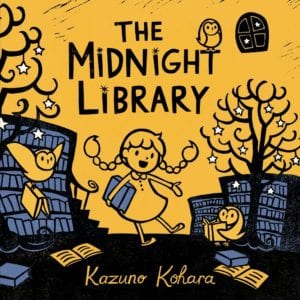One of the questions I see come up most often online is “how do you do library tours?” And I understand why because I struggled with this too. How did we make classes visiting our library an actually productive experience instead of just come check-box for teachers to kill an hour? I did a lot of thinking about this and, as always, I sought out the experience of my awesome colleagues. The incomparable Bryce‘s writings about class field trips was essential to my thinking. To begin, read some of Bryce’s writing on this Preschool Field Trip Adventure and Tour It Like You Mean It are two of her best. The fantastic Dana and Lindsey at Jbrary have a round-up of posts about tours which is also super helpful.
I also realized we needed a change in how we did tours and class visits because we were seeing an increase in them during the school year – and that was GREAT. And, in fact, I wanted to boost those numbers even more. I’ve written about our Celebrate A Grade initiative before and it is a big driver to motivate teachers to bring in their classes for visits. Since I am regularly sending e-mails inviting teachers and classes to tours, I felt like that was a commitment I was making to ensuring the best experience.
Now, we have tours down to a routine. That means we can pull them together without a huge investment of staff time or panic. It means that we deliver a consistent experience across the board and everyone feels more comfortable with tours, which means less stress!
Here’s my major disclaimer: we do these tours with a lot of staff. Well, sometimes we can do them with just two of us but sometimes it takes four of us – and that’s not counting whoever has to cover the desk (assuming they are visiting when we’re open to the public.) Why so many people? Partially because we want the tour to run as smoothly as possible but also because we have an entire grade visiting us. Our town has five elementary schools and each grade level has 2-3 classes. Often, they all come together. With that many kids – between 35-60 – having more than one staff member gives us the ability to break them into their classes and really give them an hands-on tour. So, I’m not claiming this is the ONLY way to do larger groups but for us it’s certainly been the most efficient for us. It’s worth the staff time investment!
As I mentioned, most of the tours come by grade level. We very rarely have mixed grade levels coming for tours. I realized we could standardize a program by grade. We came up with three basic tour plans: K-2, 3 & 4, and 5 & 6. This blog will go over our outline for K-2, but I plan to post the plans for all our tours.
So, how does a K-2 tour go? Here’s our plan!
- All tours are made up of three stations: a story, an actual tour through the library, and a craft. This gives the kids a chance to move around (too much sitting in this age group is a killer), engages all different kinds of learners in an activity they’ll connect with, and gives the kids a chance to see lots of different elements of the library.
- We ask teachers to plan for an hour at the library – which gives us 20 minutes to rotate through each of the three stations.
- If the teachers have two classes in their grade level, we do the tour and story separately and then come together to do the craft in the final 20 minutes. If the teachers have three classes in their grade level, we just rotate one by one through the stations.
- We try to keep the tour part for the K-2 level fairly simple. For the older kids we talk more about the mechanics of the library. For the K-2 tours we focus more on where their collections are located, where they can sit and play/read/color, where they return books. This is basic intro to your library 101.
 At the story station we read the book The Midnight Library by Kazuno Kohara. This is the perfect book for this age group, not too long but still with lots of funny parts. AND it’s another great intro into what the library does/what you can do when you visit the library (there are areas to be louder and areas to be quieter, you can get a card to take books home, the librarian can help you find the just right book!) We count the assistant owls, laugh at the funny voices of the animals, notice the details. The story station is also where we spend a little bit of time talking about how glad we are they are here visiting, how we want them to come back to see us.
At the story station we read the book The Midnight Library by Kazuno Kohara. This is the perfect book for this age group, not too long but still with lots of funny parts. AND it’s another great intro into what the library does/what you can do when you visit the library (there are areas to be louder and areas to be quieter, you can get a card to take books home, the librarian can help you find the just right book!) We count the assistant owls, laugh at the funny voices of the animals, notice the details. The story station is also where we spend a little bit of time talking about how glad we are they are here visiting, how we want them to come back to see us. - At this station we also take some time to learn a song/rhyme or two. It both helps the kids focus and burns off a little energy which gets them ready to sit and listen to a story. The teachers really like this part too and it makes the kids more comfortable with you.
- The craft station is … make your own owl assistant! We have created a simple owl for the kids to color and we make them into lanyards. This also gives them a fun thing to take home. We’ve seen so much creativity when the kids are let loose on the owls. Sometimes they add books for the owls to hold – since they’re library assistants. Sometimes they make it night behind them – since that’s when they work in the library. I’ve seen owls with muscles, owls in trees, owls in dresses, and even a demon owl. If the kids finish coloring, we suggest they draw a picture on the back of something they love to do at the library. Let’s have some adorable pictures!



Want the template for the owl? (We get four on a page) (2023 UPDATE: This is a link to the Canva template, it’ll prompt you to make a copy. It’s not very fancy since it’s the old one I made back in 2015 but you can use Canva to fix it up, haha.)
And that’s just about an hour. As they are finishing their coloring we call attention back to us and thank them for visiting us and ask them to come back and see us and generally do a wrap-up/thank you/goodbye cheer.
We get great feedback from these tours: teachers compliment us on how well run they are, kids often come back and shout DO YOU REMEMBER ME? I know that me and my staff certainly appreciate how much easier to manage, organize, and implement the tours are. We stress a lot less over them now because we know what works and we know how to set it up and what we’ll need to pull one off.
We’ve already had five visits this year (many of which were due to the fact we built a new branch library – so it was even more helpful to have this plan down to a routine!) and I’m looking forward to even more as the school year goes on.
In my next posts for this series, I’ll write about our plans for the other grades
How do YOU do tours and class visits? What works for you? What have you had to discard? How often do you get class tours from your schools? Tell me all about it in the questions – and ask about anything from this post you want more info on – or chat with me on Twitter.




Thanks so much for writing this up. The only thing I could possibly think to add is this post where you scroll down and there’s a link dump of field trip scripts for different ages. http://brycedontplay.blogspot.com/2014/11/hows-and-whys-of-our-successful-field.html
At my former library we also used multiple people, and it’s definitely worth it for a lot of reasons. With scripts, smaller staffed libraries can use volunteers if they want to explore this route!
I love the owl assistant idea, and you’re so right about the feedback– when the library is THE PLACE kids and teachers want to go, it’s a beautiful thing that YOU as a department DID. Whoa.
I look forward to reading the rest of the series!
Thank you so much for posting this! I read this when you posted it on Storytime Underground and put it in my memory banks. Lo and behold, a few weeks later, I had 3 PreK classes call to schedule tours. This is incredibly helpful. I’m continually amazed by the sharing community. 🙂
This is great! Exactly what I needed. I concur with Tara G; so grateful for such a supportive and sharing community!